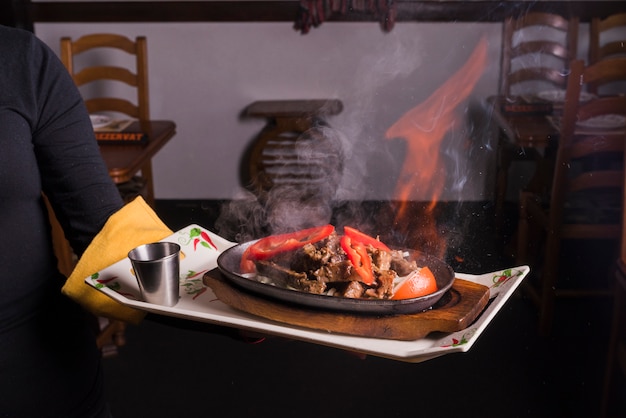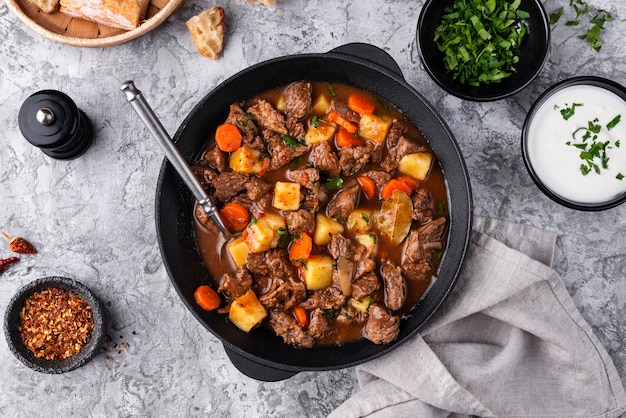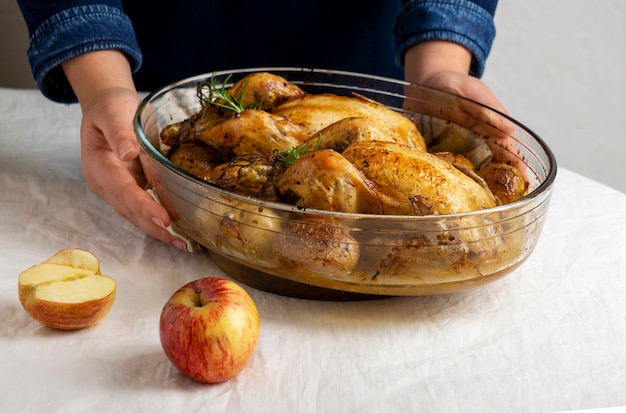There's something about the aroma of a hearty beef stew simmering in the oven that just screams "comfort food." It's a dish that instantly transports you to a cozy evening by the fire, surrounded by loved ones. But let's be honest, crafting a truly delicious beef stew isn't always as simple as it seems. Getting that perfect balance of tender beef, flavorful gravy, and perfectly cooked vegetables can be a bit of a culinary puzzle.
Over the years, I've experimented with countless recipes and techniques, constantly striving to perfect my beef stew. I've learned that the key to a truly exceptional stew lies not just in the ingredients, but also in understanding the subtle nuances of the cooking process. In this article, I'll share my tried-and-true method for creating a beef stew that will have everyone begging for seconds. We'll delve into the details, explore helpful tips, and answer some common questions, so you can confidently embark on your own stew-making adventure.
(Part 1) Choosing the Right Beef: The Foundation of Flavor

The first step in any great beef stew is selecting the right cut of meat. Think of it as the foundation upon which the entire dish is built. You need a cut that will hold up to the long cooking process, becoming incredibly tender and flavorful as it simmers in the oven. For me, the top contenders are always chuck roast and boneless beef shoulder.
Chuck roast, often considered a "tough" cut, is actually a perfect choice for stewing. It has a good amount of fat marbling, which melts away during cooking, keeping the meat juicy and adding a richness to the gravy. Boneless beef shoulder is another excellent option, offering a similar tenderness and depth of flavor. It's usually a bit leaner than chuck roast, but it still cooks up beautifully.
Tips for Selecting the Perfect Beef
- Look for marbling: Marbling, those white streaks of fat running through the meat, is crucial for tender and flavorful beef. You want a piece with a good amount of marbling, but not so much that it's overly fatty. Think of it like a balance between lean and fat, each contributing to the final outcome.
- Choose a good size: For a standard family-sized stew, aim for a chuck roast or beef shoulder that's around 2-3 pounds. This will give you ample meat to feed a group, without being overwhelming.
- Invest in quality: Don't be afraid to splurge on a good quality piece of beef. It really makes a difference in the final taste and texture. You'll be able to taste the difference, and your family will appreciate it too!
(Part 2) Browning the Beef: Unlocking Flavor and Texture

Once you've got your beef, it's time to get your hands dirty and give it a little love before it goes into the oven. This is where browning comes in - a simple but crucial step that will elevate your stew to a whole new level. Browning the beef before simmering it creates a beautiful crust on the outside, which adds a depth of flavor and helps to lock in all those delicious juices.
Think of it like a magic trick - you're using heat to transform the surface of the beef, enhancing its texture and aroma. It's a process that transforms the ordinary into something truly special.
How to Brown Beef for the Perfect Stew
- Pat it dry: Start by patting the beef dry with paper towels. This is essential because it allows the beef to brown properly, rather than steaming, which can result in a bland and watery texture.
- Heat the oil: Heat a generous amount of olive oil or vegetable oil in a large dutch oven or oven-safe pot over medium-high heat. Make sure the oil is hot enough before adding the beef. This ensures a proper sear and prevents the meat from sticking to the bottom of the pot.
- Work in batches: Don't overcrowd the pot! If you add too much beef at once, it will steam rather than brown. Brown the beef in batches, giving each piece ample space to sear beautifully on all sides.
- Season generously: Season the beef liberally with salt and pepper. This adds flavor and helps to draw out the moisture, creating a deeper, richer taste.
- Rest and repeat: Once the beef is nicely browned, carefully remove it from the pot and set it aside on a plate. Repeat this process with the remaining batches of beef, making sure each piece gets its own moment in the spotlight.
(Part 3) Sautéing the Vegetables: Building a Flavorful Base

Now that the beef is safely resting, it's time to focus on the delicious supporting cast of characters – the vegetables. Beef stew is a wonderful canvas for culinary creativity, and you can really personalize it with your favorite vegetables. My go-to combination includes carrots, onions, and potatoes, but the possibilities are endless.
The key here is to sauté the vegetables until they're slightly softened, allowing them to release their natural sugars. This step not only adds depth of flavor but also helps to thicken the gravy, creating a silky, velvety texture.
How to Sauté Vegetables for a Delicious Stew
- Chop them up: Prepare your chosen vegetables by chopping them into bite-sized pieces. For potatoes, I prefer larger chunks to prevent them from becoming mushy during the long cooking time. It's all about finding that perfect balance between tenderness and texture.
- Use the same pot: Add the vegetables to the same pot you used for browning the beef. Sauté them over medium heat, stirring frequently to ensure even cooking and prevent any sticking.
- Don't overcook: Remember, the goal is to soften the vegetables, not to cook them completely through. They'll finish cooking in the oven with the beef and gravy. So, keep an eye on them and remove them from the heat just before they reach that "mushy" stage. They should still have a slight bite to them.
- Add a touch of magic: This is where you can really bring out the flavor of your stew. I love adding a generous pinch of dried thyme, rosemary, and a bay leaf to the vegetables while they're sautéing. These herbs infuse the vegetables with an irresistible aroma and complement the beef beautifully. Feel free to experiment with your favorite herbs and spices to create your own signature blend.
(Part 4) Creating the Gravy: The Heart and Soul of the Stew
Now, we come to the heart and soul of the stew - the gravy. It's the element that pulls everything together, coating the meat and vegetables in a velvety embrace and creating a symphony of flavors. There are various ways to create a delicious gravy, but I'm a fan of the simple flour-based roux method. It's easy to make, reliably produces a smooth, flavorful gravy, and it's a technique that every cook should master.
How to Make a Flavorful Flour-Based Roux for Your Stew
- Whisking in the flour: Once the vegetables are sautéed, sprinkle about 2 tablespoons of all-purpose flour into the pot. The flour will absorb some of the juices released from the vegetables, creating the foundation for a luscious gravy.
- Cook the flour: Cook the flour over medium heat for 1-2 minutes, stirring constantly, until it's fragrant and begins to turn a light golden color. This step is essential because it helps to cook out any raw flour taste, resulting in a smooth, flavorful gravy.
- Adding the broth: Slowly whisk in your chosen broth, a cup at a time, until you have a smooth, thick gravy. I prefer using beef broth for an extra boost of flavor, but chicken broth or even vegetable broth can be equally delicious. Just choose your favorite!
- Seasoning is key: Once the broth is added, season the gravy generously with salt and pepper to taste. Remember, you can always adjust the seasoning later, so start with a little and add more as needed.
(Part 5) Reuniting the Stars: Assembling the Stew
Now, for the grand finale - bringing all the components together to create a culinary masterpiece. This step is simple but crucial for achieving a perfectly balanced stew. We're essentially making a symphony of flavors, where each element plays a vital role in the overall harmony.
How to Assemble Your Beef Stew for Oven Cooking
- Return the beef: Gently place the browned beef back into the pot, ensuring it's fully submerged in the flavorful gravy.
- Simmer and cover: Bring the stew to a simmer over medium heat, then reduce the heat to low, cover the pot tightly, and transfer it to a preheated oven at 350 degrees fahrenheit. The low and slow approach allows the beef to tenderize beautifully and the flavors to meld into a symphony of deliciousness.
- Cook until tender: Let the stew simmer in the oven for 2-3 hours, or until the beef is so tender that it falls apart effortlessly when you use a fork. It's a testament to the power of slow cooking - the gentle heat works its magic, transforming tough beef into a meltingly tender delight.
(Part 6) Final Touches: Polishing Your Culinary Creation
After those hours of slow simmering, your beef stew is ready for its final transformation. It's time to add those finishing touches, bringing out the very best in your culinary creation.
Tips for Finishing Your Beef Stew
- Thicken the gravy (if needed): If you find the gravy is a bit thinner than you'd like, you can thicken it by whisking in a small amount of cornstarch slurry. A cornstarch slurry is simply a mixture of cornstarch and cold water. Add it to the stew and simmer for a few minutes, and watch as the gravy magically thickens, creating a richer, more satisfying texture.
- Add a touch of acidity: To balance out the richness of the stew, I like to add a squeeze of fresh lemon juice or a splash of red wine vinegar right at the end. This brightens up the flavors, cuts through the richness, and adds a touch of complexity, elevating the dish to a whole new level.
- Garnish and serve: To finish off the stew, I like to garnish it with fresh parsley or a sprinkle of chopped chives. It's a simple touch that adds a pop of color and freshness. Serve the stew hot, with a side of crusty bread for soaking up the delicious gravy. It's the perfect combination of comfort and satisfaction.
(Part 7) The Art of Patience: The Beauty of Slow Cooking
Cooking a perfect beef stew is a journey, not a race. It takes patience, a willingness to let the flavors develop slowly over time, and an appreciation for the magic that happens when you allow the oven to work its culinary wonders. The long, gentle heat of the oven is what transforms the tough beef into a succulent masterpiece, with each hour adding to the depth of flavor and tenderness.
It's a testament to the power of slow cooking - a technique that allows us to savor the process and create something truly exceptional. It's a reminder that sometimes, the most rewarding things in life take time and care.
Benefits of Slow Cooking
- Tender, melting meat: Slow cooking breaks down the tough connective tissue in the beef, resulting in incredibly tender meat that practically melts in your mouth. It's the kind of meat that just falls apart with the gentlest nudge of a fork, making each bite a delightful experience.
- Intense, layered flavors: The long cooking time allows the flavors of the meat, vegetables, and herbs to meld and develop, creating a complex and harmonious symphony of taste. It's like a culinary orchestra, with each ingredient playing its part in the overall masterpiece.
- Effortless and convenient: Once you assemble the stew, it's basically hands-off cooking. Pop it in the oven and go about your day, knowing that a delicious meal is patiently simmering, ready to warm your heart and satisfy your cravings. It's a wonderful way to create a comforting meal without spending hours in the kitchen.
(Part 8) The Verdict: A culinary journey Worth Embarking On
I can't stress enough how much I love making beef stew. It's a dish that brings people together, fills the home with warmth, and reminds us of the simple joys of good food. It's a testament to the power of slow cooking - a technique that takes time, care, and patience, but rewards us with a truly unforgettable experience.
If you're looking for a comforting, satisfying meal that's perfect for chilly evenings, I highly encourage you to give this beef stew recipe a try. Trust me, it's worth the wait. You'll be rewarded with a delicious stew that will have everyone asking for seconds, and you'll find yourself wanting to make it again and again.
FAQs
1. Can I use a different cut of beef for this recipe?
While chuck roast and boneless beef shoulder are my go-to choices, you can experiment with other cuts like brisket or even short ribs. Just remember to adjust the cooking time accordingly, as these cuts may take longer to become tender. It's all about understanding the different cooking times and textures of various cuts of beef.
2. Can I make the stew in a slow cooker?
Absolutely! You can easily adapt this recipe for a slow cooker. Brown the beef and sauté the vegetables as described in the recipe, then transfer everything to a slow cooker. Cook on low for 6-8 hours or on high for 3-4 hours. The slow cooker will do all the work for you, resulting in a perfectly tender and flavorful stew.
3. What can I add to the stew to make it even more flavorful?
Get creative! You can add a tablespoon or two of red wine vinegar to the stew for a tangy kick. A pinch of smoked paprika or a bay leaf can also add a smoky depth of flavor. Don't be afraid to experiment with different herbs and spices to find your perfect combination. A sprinkle of fresh thyme, rosemary, or oregano can add an extra layer of flavor and aroma.
4. Can I make the stew ahead of time?
Yes, you can! Make the stew a day or two in advance and store it in the refrigerator. Just reheat it gently on the stovetop or in the oven before serving. The flavors will actually meld even more as the stew sits in the fridge, resulting in an even more delicious outcome.
5. What are some good side dishes to serve with beef stew?
Beef stew pairs well with a variety of side dishes. Classic options include mashed potatoes, crusty bread, or a simple green salad. For a more adventurous touch, try serving it with polenta, roasted root vegetables, or a creamy risotto. Let your creativity run wild and find the perfect complement to your delicious stew.
Everyone is watching

Corn on the Cob: The Ultimate Guide to Perfectly Cooked Ears
Healthy MealsAh, corn on the cob. Just the name evokes images of sunny days, barbecues, and that sweet, juicy flavour that ...

Scallops: The Ultimate Guide to Perfect Cooking
Healthy MealsAh, scallops. Those delicate, sweet, and utterly delicious morsels of the sea. They hold a special place in my...

Spaghetti Squash: The Ultimate Guide to Cooking and Serving
Healthy MealsRemember that time you saw spaghetti squash at the supermarket, looking all bumpy and strange, and thought, "W...

Salmon Cooking Times: Perfect Guide for Every Recipe
Healthy MealsLet me tell you, cooking salmon is an art form. It's all about getting that perfect balance: juicy and tender,...

Ham Cooking Time: How Long to Bake, Smoke, or Boil a Delicious Ham
Healthy MealsAh, ham. It's a classic, isn't it? A real crowd-pleaser, especially around holidays. And when done right, it'...
